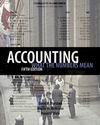 |  Accounting: What the Numbers Mean, 5/e David H. Marshall,
Millikin University
Wayne W. McManus,
International College of the Cayman Islands
Daniel F. Viele,
Webster University
Accounting for and Presentation of Property, Plant, and Equipment, and Other Noncurrent Assets
Chapter 6 Learning ObjectivesAfter studying this chapter, you should understand:
1.How the cost of land, buildings, and equipment is reported on the balance sheet. |
 |  |  | 2.How the terms capitalize and expense are used with respect to property, plant, and equipment. |
 |  |  | 3.Alternative methods of calculating depreciation for financial accounting purposes, and the relative effect of each on the income statement (depreciation expense) and the balance sheet (accumulated depreciation). |
 |  |  | 4.Why depreciation for income tax purposes is an important concern of taxpayers and how tax depreciation differs from financial accounting depreciation. |
 |  |  | 5.The accounting treatment of maintenance and repair expenditures. |
 |  |  | 6.The effect on the financial statements of the disposition of noncurrent assets, either by abandonment or sale. |
 |  |  | 7.The difference between an operating lease and a capital lease. |
 |  |  | 8.The similarities in the financial statement effects of buying an asset compared to using a capital lease to acquire the rights to an asset. |
 |  |  | 9.The meaning of various intangible assets, how their values are measured, and how their costs are reflected in the income statement. |
 |  |  | 10.The role of present value concepts in financial reporting and their usefulness in decision making. |
|


 2002 McGraw-Hill Higher Education
2002 McGraw-Hill Higher Education